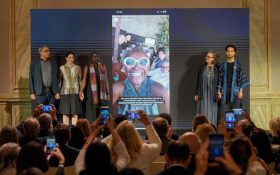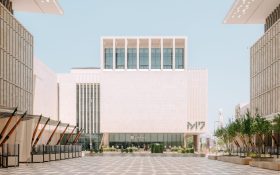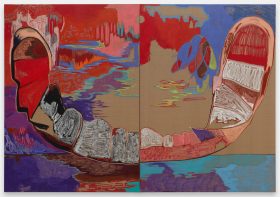The path to good public art actually begins way before an artistic idea blossoms. Just like the space it will inhabit, foundations are crucial.
Commissioning bodies and their approach will have as much influence on the outcome of public art as the artists, and this is where a clear brief can form a healthy basis for the work.
‘The process starts very early on, long before the artwork is even conceived. Good practice is to have a really clear expression of interest or brief so that artists understand what the commissioner is asking for,’ says Fiona Hillary, who heads up Art in Spaces, a Masters of Arts program in public art at Australia’s RMIT college.
In addition, thinking about who’s going to be on the selection panel, how the community can be engaged in the process, and bringing in the voices of Traditional Custodians [First Nations], are integral parts of that process.
Lisa Byrne, Director of McClelland [a foundation that supports public art in Australia], who recently helped deliver Sound Shell by Christabel Wigley to the Victorian Peninsula’s newest hub that lays a creative lens over a shopping hub, told ArtsHub: ‘Having that balance of expertise and knowledge across the representation on your panel makes for a very strong outcome. It means that you get a work that does resonate in its location for a variety of reasons.’
Increasingly, commissioning bodies are seeing the importance of bringing on board art and culture consultants such as McClelland and First Nations Curators to steer the direction of projects such as the recently launched 9km art trail, Yananurala, led by Emily McDaniel.
With so many moving parts, what constitutes good public art has to be judged almost on a case-by-case basis, responding to specific needs and environments. And sometimes, ‘good art’ might not be what’s the most suited or appropriate.
Byrne continued: ‘For artists, it’s about realising that you’re working with a whole skill set including engineers, designers, architects and stakeholders.
‘You need to think about occupational health and safety, the expectations of the commissioning body – which might be government entities – and the location in which the work is placed. And you need to be able to speak their language as well as know your own as an artist,’ she added.
Read: On gender, pay and public art
Even with such considerations, public art inherently harbors an element of unpredictability. It’s often put at the mercy of flora, fauna, and of course, people. In many ways, it’s what makes public art exciting.
We should ‘be mindful that a public art work has to have some time to sit in the space and for people to experience it over years,’ Byrne said. ‘There’s the idea that the work is static. But it’s not. There is the work in itself and then there is the work in relation to what’s going on around it.’
Permanent works can become landmarks and destinations as time goes on. Hillary also mentioned that temporary interventions and activations can be equally powerful.
‘I love the nature of temporary public art because you can create a kind of research laboratory that scratches the surface of what that site has been in the past and what it has the potential to be in the future,’ said Hillary.
‘I think temporary public practice really gives us an opportunity to question and make public space perceptible. It helps us understand that it’s not just a backdrop to our lives, but part of that lived experience. We’re entangled with it as much as it’s entangled with us.
‘Good public art can mirror contemporary issues, question, celebrate or critique contemporary society,’ said Hillary.
Is social media a meaningful indication of public art’s reception?
After the selection, consultation and realisation process, is there any way to measure the impact the work has on the public? With the growing saturation of works in public spaces, viewer interaction most prominently features in the form of social media photos, tags and comments.
Byrne said: ‘I think [social media] gives you a sense of the scope of engagement of a work, but it’s not necessarily a good measure of artistic value because you’re getting a very broad range of opinions on social media.
‘Also, there are constraints that amplify certain things within the constructs of those software platforms. You have to be mindful that things can be skewed,’ she continued.
Read: Is the Hosier Lane attack vandalism or street art?
In other ways, this scope signals the generation of discourse, something which Hillary thinks as responses worth considering.
Hillary said: ‘If we are attentive to things like social media and the media, we can get a sense of public response. Even when the public finds an artwork difficult, it raises a whole range of questions, both in the community and with the commissioning body and local government organisations. It starts a really interesting dialogue.’
When public art is challenging, it really gives us an opportunity to have some conversations and dialogue that might not have happened so publicly, or so loudly.
Fiona Hillary
Advice for artists responding to a brief
‘If you’re interested in working in the public space, a key thing is knowing the site,’ said Byrne.
‘Know what’s happening around the site, the history of the area and really do some deep research. Think about how your practice as a sculptor or artist can work within those parameters and those constraints within that area so that you’re making a work which resonates.’
Hillary’s advice similarly stressed the importance of these precursors.
‘Read the brief very very carefully and get your questions answered if there is anything unclear. As artists, we have to be really aware of the work we undertake, and the parameters that are put in place for that work to be commissioned,’ she said.
Hillary stresses that ‘artists should always be paid for their ideas.
‘A brief should only ever ask for a written description and maybe some images of previous work for that first stage of selection. Be very clear about the ownership of your ideas and what is your intellectual property.’





